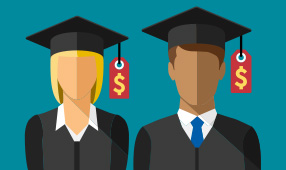Educators know that an organized classroom makes their jobs easier and allows them to focus on what’s most important — teaching.
And those same organizational tactics you use to make a classroom run smoothly can be used to manage your own personal finances.
Check out these six organization principles to see how using the methods you already know can help you achieve your money goals.
1. “Keep your desk clean.”
A cluttered desk can be distracting and make you lose sight of what you want to accomplish that day, week or semester.
The same principle applies to setting financial goals.
You might have lots of ideas about what you’d like to do with your money, but you’ll likely have more success if you list specific goals and prioritize them. Then write down what you need to do to achieve those goals and a timeline.
For example, say you want to put a $4,000 down payment on a new vehicle in two years. That means you’ll need to save about $166 per month for 24 months. Or maybe a close friend’s destination wedding in one year will cost you $1,200 out of pocket, which you can manage by putting aside $100 a month.
You can have goals for the near-term or long-term, and you can save for more than one at a time. That means you can save for that down payment or destination wedding while also regularly squirreling away money for your retirement that’s decades away.
Get some smart tips on “How to Reach Your Financial Goals Faster” by learning how to be a strategic saver.
2. “File and label your documentation.”
When you keep tabs on your financial situation, you’re reducing the likelihood that anything will take you by surprise.
A budget that labels recurring expenses and income is one way to keep tabs on where your finances stand. Knowing how much money you have going in and out each month can reveal non-essentials that you can trim. Then you can put the money toward one of your goals instead. Download our free workbook, Build Your Budget in 6 Easy Steps, which guides you through the budgeting process.
A budget is not static, however. Consider using online tools, such as Mint.com, to track spending and ensure you stay within your budget. And regularly monitor the progress you’re making toward your goals.
3. “Clean up messes.”
Paper can pile up quickly in and out of the classroom. As you tidy up your files at home, consider this list of documents that you can toss after a short time – and those that you need to retain.
- Utility bills and other routine monthly living expense bills. You generally can dispose of bills after you’ve paid them, noted them in your check register, and the checks have cleared. Similarly, you no longer need to keep ATM withdrawal or deposit slips once the transactions appear in your bank account.
- Bank and credit card statements. Keep paper statements for 12 months after making sure they’re accurate. Better yet, eliminate the paper altogether by managing bank and credit card accounts online, which allows you to get digital access to statements going back years.
- Classroom supplies receipts. Teachers will be able to deduct up to $300 they spend out of pocket for classroom supplies on their 2023 tax return. So even if you make small cash purchases throughout the year, keep those receipts for tax time.
- Tax returns, W-2s and other tax-related documents. You’ll need to keep these for at least as long as the IRS has to audit you, if not longer. The IRS has three years from the date you filed your return or the due date (whichever is later) to audit your return; or six years if you underreported your gross income by more than 25%. Also keep records for seven years if you are claiming a loss from worthless securities or a deduction for an uncollectible loan.
There are some exceptions, such as fraud, when the IRS has no time limit for an audit. But even if you never fall into one of these exceptions, many financial advisers suggest keeping a copy of your tax return forever, which can help you prepare future returns, provides a record of past income if a lender ever asks and can be a good record of your financial progress. - Investment and property records. Keep these for at least three years after selling the investments or property.
- Home documents. Keep documents related to the purchase of your house, as well as any receipts or records of home improvement expenses that will increase the cost basis (the cost of the house to you). When you eventually sell, you’ll use the cost basis to determine whether you owe any capital gains tax on the sale.
- Documents to keep for life. These include birth and adoption records, marriage certificates, prenuptial agreements, divorce settlement agreements, Social Security cards, military discharge papers, wills, powers of attorney and life insurance policies.
Many documents contain personal information useful to an identity thief, such as your Social Security number, bank account and routing information, credit card numbers, driver’s license number, signature, medical records, or usernames and passwords. So, when disposing of documents, make sure you do so in a way that doesn’t expose your personal information to an enterprising identity thief rummaging through your trash or recycling bin. Consider running documents through a cross-cut paper shredder or taking the papers to a community shredding event offered for free in many cities.
4. “Put stuff where it will be used.”
Just as you make it easy for everyone to access supplies in the classroom, you can set up tools and accounts online to make it easier to manage your finances and reach your financial goals.
For example, direct deposit of paychecks and tax refunds is not only safer than receiving a paper check, but it also gets your money into your bank account faster. Online banking makes it easy to monitor your account; get notifications, such as low balance and large purchase alerts; or set up recurring or automatic payments to utilities or other businesses so you don’t miss a deadline and get hit with a late fee.
In fact, setting up automatic payments with your student loan servicer may qualify you for a special interest rate reduction. See what you could save with an autopay rate reduction through the NEA Student Loan Program in partnership with College Ave Student Loans.
Putting your retirement savings on autopilot can make it easier to build a nest egg as well. You can have money automatically deducted from your paycheck and deposited into your 457 or 403(b) plan, which will reduce your current taxable income. Check the NEA Retirement Program for options that may be available in your school district.
And if your plan offers target-date funds, you could choose a fund closest to your anticipated retirement date and have a professional manager make all the investing decisions for you. That includes adjusting your portfolio to be more conservative as you approach retirement age.
Also, keep important papers, such as birth and marriage certificates, insurance policies, loan documents or other key papers in a safe place, such as a fireproof box, that you or others acting on your behalf can easily access if needed.
5. “Have a back-up plan.”
You may have a folder with a seating chart and lesson plan in case of an emergency that calls for a substitute teacher to step into your shoes. But you also need to be prepared for emergencies in your personal financial life.
A good place to start is building emergency savings so you don’t have to rely on family or a credit card to cover a surprise bill. The standard recommendation is to set aside three to six months’ worth of living expenses in a separate, high-yielding savings account that’s easily accessible in emergencies.
It will take time to salt away months’ worth of living expenses, so don’t get discouraged. Even if you manage to set aside only $400 after several months, that may still be enough to cover many unexpected expenses, say, a car repair or broken appliance. And $400 is more than many people have saved for emergencies. A 2021 survey by the Federal Reserve found that nearly one-third of adults didn’t have enough cash on hand to cover a $400 emergency expense.1
Insurance is another way to protect against emergencies. Make sure you have adequate insurance for your house. Or, if you’re a renter, you can purchase a renter’s policy to cover your belongings, provide you with temporary living expenses if your apartment is damaged and more. And you’ll need life insurance if anyone is dependent on your income. For example, the life insurance options from NEA Member Benefits can help supplement your school district’s coverage.
If you find yourself in an emergency without a big-enough savings safety net, another option is to take out a short-term loan. This can help you cover unavoidable but necessary expenses such as traveling to attend a loved one’s funeral, or paying to replace your car’s transmission. Consider the NEA Personal Loan, which offers competitive rates, flexible payment options and more on loans up to $30,000.2
Learn more in our Tips to Help Educators Manage a Financial Emergency.
6. “Keep track of participation.”
Recognizing students’ participation with a small reward system can encourage them to continue taking part in class discussions. Similarly, rewarding yourself for achieving financial tasks can motivate you to keep taking steps to reach your goals.
Make sure the reward is inexpensive and doesn’t derail your financial progress, though. For busy teachers with lots of demands on their time and attention, a reward can be as simple as some me-time, say, spending a day reading a novel, visiting a museum, going to lunch with a friend, or watching a movie in a theater—with a tub of popcorn.
Make your financial organization plan today
A healthy financial life is key to achieving your goals. Use the steps above, and find out what steps you can take to further improve your financial wellness. Plus, sign up for our 4-part “Financial Whiteboard” email series where you can learn more about important money matters such as managing student loan debt, building your credit, planning for retirement, and more.
1 Economic Well-Being of U.S. Households, Board of Governors of the Federal Reserve System, August 2022.
2 The NEA Personal Loan cannot be used to pay for postsecondary educational expenses or tuition or to consolidate postsecondary educational loans.
Loans are made and serviced by First National Bank of Omaha (FNBO®).
The NEA Retirement Program ("NEA Program") provides investment products for retirement plans sponsored by school districts and other employers of NEA members and individual retirement accounts established by NEA members. Security Distributors and certain of its affiliates (collectively, "Security Benefit") make these products available to plans and accounts pursuant to an agreement with NEA Member Benefits (“MB”), which markets the NEA Program. NEA and MB are not affiliated with Security Benefit. Neither NEA nor MB is a registered broker/dealer. All securities brokerage services are performed exclusively by the local sales representative's broker/dealer and not by NEA or MB. NEA Retirement Specialists, when making recommendations to an NEA member, offer only Security Benefit products.













